- "The body—cocoon. The soul—chrysalis. Eclose, wings dry, in the Force."
- ―Korroth
Korroth is a Jedi Consular of Clan Odan-Urr. He is enlisted as a sapientology researcher and combat Healer in Garza’s Pathfinders, a battleteam of Joint Task Force Satele Shan on Daleem. His principal interest and activity is study of the Force and how it shapes the philosophies of the Sith, the Jedi and the millennial conflict that exists between them. His own understanding of the Jedi and Sith as the wellsprings of peace and war, union and division, serenity and desire is what motivates him to fight on the side of Clan Odan-Urr in their current opposition to the Dark Lord of the Sith.
The Pau'an has walked the path of the Jedi for a mere seven years, but the impulse to unravel the message of the Force was with him from the beginning. In his youth this seeking led to banishment from his hometown on Utapau and capture by Zygerrian slavers. The life of a thrall was cruel and grim, but he was fortunate to share it with a mentor, a fellow slave and a former Jedi who transmitted to Korroth his knowledge of Sith and Jedi history.
In 20 ABY the crash of his slavemaster’s ship was both a tragedy and a new opportunity, because in that incident he lost his revered mentor but found the Brotherhood. He pursued the ways of the Krath, seeking clarity in the Force through the kaleidoscope of Brotherhood power structures. His studies brought him to the Cocytus Empire, where he began to form a close rapport with the natives of Antenora. In his endeavour to discern how the Empire, the Force and the native population interlaced to form an ordered society, he came to understand that his Sith overlords worked not through order, but division, fear, strife and imbalance. Korroth felt the will of the Force speak to him when rumors surfaced of a Jedi planet discovered by the Brotherhood.
Korroth was among the light side sympathizers who were shipped off to New Tython in 28 ABY. There he embarked on the Jedi path, in the knowledge that giving his strength to House Odan-Urr was his best hope of opposing the Sith menace. His approach to understanding the ways of the Jedi and the House was to seek a closer connection with the life of the planet. However, his anthropological study of the native Harakoans was curtailed by the onset of war. The disastrous Invasion of New Tython forced Korroth to acknowledge the bond between Odan-Urr and the Brotherhood. Unable to come to terms with the inevitable integration of the House into the structure of the dark side organization, the Pau’an left active service and wandered as a hermit on New Tython. During these years he began to wonder how a Jedi could find peace and still act as an agent of good in the galaxy. His answer came in 34 ABY when Darth Pravus attacked and destroyed New Tython. With the outbreak of open war Korroth submitted to the will of the Force and joined Odan-Urr in their struggle.
Character History
Utapau
City of Birth
2 BBY - 9 ABY
- "Let the councils go to war for ideals, honour, pride, justice. A soldier fights for home and hearth."
- ―Tuvon Karn
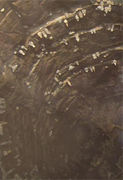 The sinkhole of Ika
The sinkhole of Ika
Korroth Karn was born in 2 BBY in Ika, a remote sinkhole city on the Outer Rim planet of Utapau. Ika was geographically isolated and both culturally and politically distinct from the planetary Utapaun society. This contrast was best exemplified, culturally, by the city's practice of an ancient animistic cult and, politically, by the Ikan City Council's autonomous rule and historical independence from the planetary government.
With the effective collapse of the Galactic Empire in 4 ABY, the re-instituted Utapaun Committee began applying pressure on Ika to integrate into planetary and galactic society. Korroth's mother Mavane was a prominent member of the governing traditionalist party on the Ikan City Council. This party took an aggressive stance towards the planetary government's perceived encroachment, and the dispute eventually escalated into a protracted war of attrition. The Utapaun Committee imposed economic sanctions and established a blockade around the entire sinkhole, while the Ikan Civil Guard retaliated with raids and skirmishes against the Utapaun security forces. In short, an event too insignificant on the galactic scale to even breach the HoloNet, but so ruinous to Ika as to bring its citizens to the brink of destruction.
Korroth's father Tuvon was a captain in the Ikan Civil Guard. Though the child’s parents loved each other very much, they often quarreled over the war. Mavane strongly believed the Ikan people would lay down their lives for the sake of freedom, while Tuvon thought the cost of this war was too high. In 7 ABY Tuvon died while leading a raid against the Utapaun blockade. Though for a time mother and son grew closer in their grief, over the years each found their own separate ways to deal with the loss. For Mavane it was the war against the Utapauns. She poured her pain into the flames of the conflict, drawing it closer around herself, the City Council and eventually her son. For Korroth the childish question “Why?” never really left him, and this earnest need to understand his father’s death colored his quests and choices for the rest of his life. In these early years it led him into the consolation of the city’s spirit cult, where he began to discover the connectedness of the spiritual and mundane worlds.
Spirit Cult
9 ABY - 14 ABY
- "Take this altar, it is the farthest reaches of the world. Take this sacrifice, it is the navel of the world. Take this fire, it is the life of the world. Take this priest, she is the speech of the world."
- ―Recitations of the spirit cult
In 10 ABY Mavane enrolled the young Korroth in the city's Cadet Corps Academy, with the intent that he would eventually become a Civil Guard officer. Korroth took to the military education with diligence, but more out of commitment to his father's memory than any aspiration for a military career. Instead, his real devotion was to the Ikan spirit cult. Whenever he could, he would assist the revered spirit guides in healing rituals, the recitation of holy hymns and the maintenance of shrines. It was while taking part in their sacred rites that Korroth was able to immerse into the spirit world, where the energies of living beings were laid bare. He glimpsed the spiritual essence of Pau’ans and Utai and he saw that they glowed with the same light, irrespective of where they fought in the war.
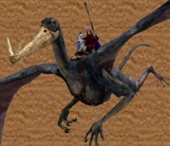 An Ikan Civil Guard
An Ikan Civil Guard
The spirit cult had a strong influence on the young Pau'an's developing political position, as his social circle consisted mainly of cult initiates. The venerable spirit guides, attuned as they were to the temper of the spirit world, saw that the war against the Utapaun Committee was bringing only grief and privation. In 14 ABY Korroth joined a dissident cabal of initiates who, believing the situation to have become too dire, intended to remove the warmongering traditionalist party from the City Council. After months of planning and covert communications, the cabal led the security forces of the Utapaun Committee through an abandoned cave tunnel and into the sinkhole of Ika. The Utapaun soldiers took control of the city barracks and apprehended the members of the City Council without bloodshed.
The Utapaun Committee soon installed a provisional city administrator and lifted the economic sanctions. The blockade dispersed and the raids stopped. In their hearts the people of Ika were thankful that they were no longer committed to a bloody war. However, they could not forgive the dissidents' traitorous actions, which had slighted their civic pride. After several days of riots and unrest, the uncontrolled lynch mobs discharged their fatal justice on the young conspirators one by one, until Korroth was forced to flee Ika and even Utapau itself. He took the first starliner he could find, which headed coreward on the Rimma Trade Route.
Slave Empire
Zygerria
14 ABY - 16 ABY
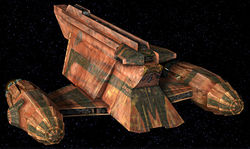 The Zygerrian slave freighter
The Zygerrian slave freighter
The starliner was still in the Outer Rim Territories when it was attacked by Zygerrian slavers of the Pr'ollerg Clan. The slavers seized every passenger, including Korroth, and imprisoned them in the cargo holds of their Aurore-class freighters. Korroth barely took notice of the woeful month-long journey. His mental state was such that the wretchedness of the cargo hold's slave pens was to him a mere sensory extrusion of the internal misery he was experiencing. The exile from his native city of Ika, the brutal killing of his comrades and his own mother’s repudiation had sheared all that had tethered him to the mundane galaxy. For a while the distraught Pau'an withdrew into his own self.
The slaves who survived the voyage arrived on Zygerria and were put to work on the construction of a slave master’s grand palace. The ordeals of slave labor taught Korroth to suppress the pain that he felt for being an exile of his homeworld, the contempt he bore for his captors and the hate he directed towards his own self for being in this situation. He could not afford to indulge any of these emotions; his every fiber was bent towards surviving the backbreaking, unending drudgery, the beatings of the older slaves and the punishments of the slave drivers.
In the long run, what saved him were his rudimentary skills of healing, taught to him in the form of rites and incantations by the spirit guides of Ika. Through his practice of the art he gained comrades amongst the slaves, people ready to stick together for mutual protection and support. These alliances allowed Korroth to survive day-to-day, but it was the Zygerrian slave master Yaj Pr'odek, owner of the grand palace being constructed, who released him from this brutal, soul-crushing state of existence. Upon inspecting the slave work crews in 16 ABY, she saw him performing his healing rituals on the other slaves and she bought him for her own retinue.
Queen Scintel III
16 ABY - 18 ABY
- "You know the truth, even if you will not admit it. The slave is only free when he submits."
- ―Lady Pr’odek
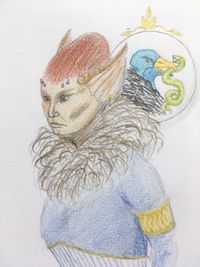 Lady Pro’dek and her Clan insignia
Lady Pro’dek and her Clan insignia
Yaj Pr'odek was the captain of the Corona-class slaving frigate Queen Scintel III. She and her crew of mercenaries, slavers and slaves raked the planets of the Trans-Hydian Borderlands for rare and exotic slaves, occasionally taking refuge in the Stygian Caldera when New Republic or First Order patrols gave chase. Korroth was assigned to assist another slave, an old Bothan named Tarc, who served the Lady as the ship’s medic. Together the two took care of captured slaves, ensuring that they were fit to travel and that they remained in good condition for the slave markets. As an experienced medical practitioner, the Bothan tutored his new pupil through the transition from spirit healer to trainee medic.
Tarc became a mentor in more than the medical sciences. It was the old Bothan who taught Korroth to recognize the Force in the ethereal energies of the spirit world. He claimed to have once been a Jedi and, though Korroth never saw evidence he could draw upon the Force himself, he showed the young Pau’an how the arts of medicine and Force healing could be woven together to restore harmony in the body of an afflicted being. He also taught Korroth a form of Jeswandi kinetic meditation. When the slaves did not perform as desired, the Lady’s choice punishment was the “hot casket,” a durasteel box in the frigate’s engine room. Tarc and Korroth used these Jeswandi meditation techniques to restore function to their bodies after enduring the casket.
Korroth’s curiosity about the nature of the Force was not entirely sated by these more practical applications. Even though it was his slave prison, the Queen Scintel III had expanded his horizons immensely. From the surface-bound view of Utapau to the galaxy-spanning vistas opened by hyperspace, Korroth finally saw that the Force was a universal principle which bound all life as one. The Pau’an wanted to understand how this omnipresent energy guided beings, shaped cultures, drove conflict and peace, so he drank in every one of Tarc’s stories about the Jedi, the Sith and their ancient wars. It was in this manner that Tarc introduced Korroth to the concept of the Force as cosmic will. It was the Force, he preached, which placed beings into the place and time that best prepared them for their destiny. Of his mentor’s teachings, Korroth was least content with this one. He was a slave, and his labor helped his slavemaster to make more slaves. He could not see how this life could rise to any form of destiny; though, at the same time, he was certain there was no other place in the galaxy for him but this one.
Felucia
18 ABY - 20 ABY
- "One breath. Tree, flower, rancor, acklay, kinsfolk. One breath. One life."
- ―Felucian Shaman
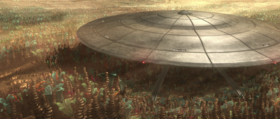 The Queen Scintel III on Felucia
The Queen Scintel III on Felucia
In 18 ABY the Queen Scintel III began surveying the planet of Felucia for potential slaves, acting on a commitment signed with a secretive group of Force users from the Esstran sector. Lady Pr’odek sent Tarc and Korroth to the surface and charged them with finding a rumored tribe of jungle Felucians and determining their suitability for the slave market. Left to their own devices in the dangerous and primitive jungle, the two slaves had no choice but to seek out the Felucians. Over the course of two years the slaves gained the trust of the tribe and came to live in their encampments. In their role as healers they built a close rapport with these people, learning to participate in many aspects of their vibrant lives and social habits. Korroth saw himself naturally drawn to their shamans’ rites and ceremonies. From the little he could perceive and interpret, the Felucians appeared to be mere instances of a single unity that encompassed their whole tribe, the jungle, maybe even the whole planet. The young Pau’an felt this was the key to unlocking a higher truth about the Force, but in the end this opportunity escaped his grasp.
The Queen Scintel III launched its attack in 20 ABY. Tarc and Korroth had long foreseen their slavemaster’s return, but their preparations were to no avail in the end. Lady Pr’odek destroyed the tribe’s encampment, seized all the healthy Felucians that survived and took Tarc and Korroth back onto the slave frigate. The two implored the Lady not to leave the surface. They felt sure that the Felucians would not survive being severed from their planet, but Lady Pr’odek had no wish to squander her investment, and Korroth thought he also sensed a great deal of fear surrounding her mysterious contractors. Willing to suffer no further dissent, the Lady shackled Korroth and threw Tarc back into the jungle, before taking to hyperspace towards the Stygian Caldera.
Without the old Bothan’s steady guidance things seemed to escalate too quickly for Korroth to handle. The Felucians, driven insane by hyperspace, broke free of their cages and rampaged through the ship. The crew managed to maintain control until they faltered into an unknown system of the Esstran sector, whereupon the Felucians stormed the bridge and the frigate crashed onto a deserted planet. Somehow Korroth survived, though on the brink of senselessness. Moments before he blacked out he glimpsed starships moving in on the wreckage.
Dark Jedi Brotherhood
Lyspair
20 ABY
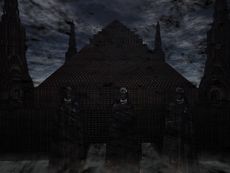 The Shadow Academy on Lyspair
The Shadow Academy on Lyspair
Korroth awoke in a medcenter of the Shadow Academy on Lyspair. He was greeted by an envoy of the Dark Jedi Brotherhood, who laid out the state of affairs for him. The Pau’an was given the choice to leave the system as soon as able, but never to return, or to stay and learn to walk the Tripartite Path in service to the Brotherhood. The Pau’an’s first thought went to his mentor. If he left now there was still a chance that he would find the old Bothan alive on Felucia, however slim the probability given the destruction wrought by the Queen Scintel III. On the other side stood the Brotherhood, a portal to untold wisdom and the deepest secrets of the Force. To be offered such an opportunity, the chance to be a part of the act by which the Force comes to know itself, surely this was what Tarc had meant by “the will of the Force”?
Once again the young Pau’an saw his past severed and cast off, but this time relinquished by his own choice. Though now he was too lost in the turbulence of the moment to see it, this decision would leave a deep scar within Korroth. Nonetheless, it was in 20 ABY, in the reign of Grand Master Jac Cotelin that Korroth was inducted into the Dark Brotherhood as an initiate of the Krath Order.
His days on Lyspair were spent perusing the vast knowledge base of this composite and intricate organization. The histories of the great and powerful of the Brotherhood, their command and arcane comprehension of the Force, galvanized the callow Journeyman and gave him intemperate aspirations. Soon he was ready to depart the Academy and take service in one of the great Clans. He transferred to Kapsina and Clan Plagueis, where he hoped to understand more clearly what his own path in the Brotherhood would be.
Kapsina
20 ABY
- "I foresee great and wicked things in the future; we will continue our path of destruction throughout the Galaxy."
- ―Jac Cotelin
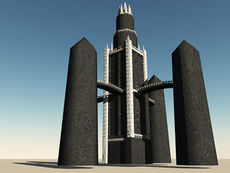 The Dark Tower on Kapsina
The Dark Tower on Kapsina
Under the Consulship of Battlelord Aabsdu di Plagia Dupar al'Tor, Clan Plagueis was an excellent introduction into the wrangling politics of the Brotherhood and its Sith overlords. Though three years had passed since the so-called "Dictum of Two Skies" which had merged the declining Clan Satak Keto and Clan Exar Kun into the current Plagueis, the turbulent ripples of the event still colored the interactions of the Clan's Dark Jedi. In observing the internal acrimony of the Clan, Korroth could reflect on how the whole Brotherhood maintained its effective unity. How could a gathering of self-serving dark side zealots, divided into rival power-vying Clans, hold together and not be destroyed from the inside? Korroth's pondering was partly answered when Grand Master Jac Ae-Sequiera Cotelin Taldrya-Cantor abdicated the Iron Throne and nominated Deputy Grand Master Aristan Dantes as his successor. The latter's ceremony of ascension to the Iron Throne as Darth Sarin demonstrated to the awestruck Journeyman the heights of power that an individual could attain through the Force, and how this individual could drag the whole Brotherhood structure up into its current shape.
In the Antei Combat Center Korroth learned the fundamentals of lightsaber combat. Using a training saber, he practiced under Archpriest al'Lan Mandragoran and then with Combat Master Dalthid, who finally accepted him as a Neophyte of the Combat Center. In practicing the simple movements of Banlanth, Korroth learned the value of focus and awareness of one's own body. He began using the basic katas as a way to center on the self and refine his connection to the Force.
During 20 ABY the Plagueis Clan Summit pushed efforts to document and gather intelligence on the Crimson Tide, an organization of pirates that had tormented Clan Plagueis since its inception. Korroth took a minor assistant role in the forensic pathology section of the research team led by Proconsul Valerian di Plagia Orzon. The Journeyman's role in this information-gathering enterprise was relatively insignificant, but it helped him to grasp that knowledge gave as much of an upper hand against the enemy as superior weaponry and tactics.
Scholae Palatinae
Antenora
20 ABY
- "When the enemy comes for you, it will not be simulation. It will not be when you are ready. When he comes for you he is sure of your death. Will you be sure of his?"
- ―Darth Sarin
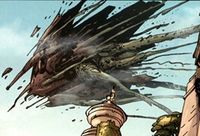 An alien ship over Suzel
An alien ship over Suzel
Towards the end of 20 ABY, while the Brotherhood fleets gathered near the Shroud to celebrate the conclusion of a series of military exercises, Korroth was sent to the Cocytus system as part of a diplomatic mission to instigate rapprochement between the Clans Plagueis and Scholae Palatinae. When the Pau’an arrived on Antenora he found that all contact with the fleets in the Shroud had been lost, and, as the capital city Suzel began evacuation, he realized that the Clans and the Cocytus system itself were under attack. He fled south but lost his way in the deserts of Batnare while strange starships flew towards the cities of the Northern Oasis. The Ser Gaa, a nomad tribe on their mammoth byerua, found him moribund and took him in.
The Ser Gaa had nursed Korroth back to health by the time Scholae Palatinae had Reclaimed their system from the alien invaders. The Krath returned to civilization but did not take the flight back to Kapsina. Maybe it was the venerable dignity and camaraderie of House Acclivis Draco, or the allure of Antenora’s desert mysteries and the secrets of the Cocytus Empire, but he decided to remain and join the House of the Rising Dragon. He felt that the answers to many pressing questions would lay in unpicking the tapestry that interwove the primitive Antenorans, the Dark Jedi of Scholae Palatinae, the Empire and the Force.
Claw of Suffering
21 ABY - 22 ABY
- "We stand as one House united."
- ―RevengeX Palpatine
Since the alien invasion and the loss of Antei and so many of the Clans' assets in 21 ABY, the Dark Council had been working to reinforce and replenish the beleaguered Brotherhood. In 22 ABY Grand Master Sarin announced major reforms concerning the dissolution of the Society of Envoys and the empowering of Journeymen, in the form of mass-produced armory lightsabers. Evidently the echelons of power wanted to prepare the Brotherhood for further engagements with the alien invaders.
In Clan Scholae Palatinae the responsibility of training and developing the Journeymen shifted towards the Rollmasters and to individual mentoring by the Equite and Elder classes. It is thus that Korroth became Prelate Lucien's apprentice for a time. The Prelate coached Korroth in the use of his new armory lightsaber in the training halls on Judecca. For the first time the Journeyman came face to face with the terrifying expediency and compressed ferocity of Vaapad, which his master used with great proficiency. In this time Korroth came to see lightsaber combat as more than a means to violence. It was a way to challenge, test and control both internal and external conflict.
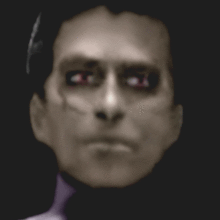 RevengeX Palpatine
RevengeX Palpatine
In this year Korroth had the honor to serve as the Claw of Suffering, Order of the Dragon: Third Class. The prestigious Order of the Dragon functioned as the Quaestor's personal guard on Antenora, protecting the Dragon's Citadel from threats external and internal. Quaestor RevengeX had instituted the Order in 20 ABY in response to the insidious Sith menace of Acclivis Draco's rival sister House Caliburnus. When RevengeX appointed Korroth in 22 ABY, the priority had shifted to domestic planetary threats.
In his duties as the Claw, Korroth familiarized himself with the intricate politics of the Antenoran locals. The ruling tribes of Li Gandor jostling for power, the vanquished remnants of the Ognerate dreaming of the glory days, the mysterious practices of the Nogarsh Hatzate, the desert nomads struggling with the pace of industrial development. Each of these could spawn a suicidal native with a vibroshiv or a well-placed bomb, and the only way to prevent this was to become intimately familiar with the tempers and expectations of the Antenorans.
It was in the course of these investigations that Korroth first encountered a drug called Hatwa. This illegal hallucinogenic substance was apparently being sourced from the planet itself. Over the years he spent on Antenora Korroth would recognize the huge cultural and social significance that this drug had for the natives. The Pau’an also became acquainted with the Haka Lakuis of Patz-Ah. This martial tribe held the greatest military responsibilities of the three Northern Tribes. With their connections to the security forces of many Antenoran cities, Korroth became a close associate of several soldiers from this tribe.
Ser Gaa
23 ABY - 24 ABY
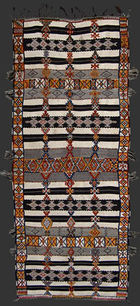 Woven fabric of Ser Gaa workmanship
Woven fabric of Ser Gaa workmanship
In 23 ABY Korroth’s period of active service as Claw of the Order of the Dragon came to an end, but the Krath felt the need to continue his investigation of Antenoran cultures. By travelling into the Sea of the Rising he hoped to observe a section of the population that had minimal contact with the Dragon’s Citadel, and therefore displayed a stronger resemblance to the “original” Antenorans, the ones that existed before the arrival of the Cocytus Empire.
Korroth encountered a number of tribes on the edges of the Sea of the Rising. He would travel with them for a span, observing their customs and practices, then he would join the next tribe they stopped to trade with, offering his healing craft in exchange for their hospitality. In this manner, he once again ran across the Ser Gaa, the Antenorans who had rescued him on his first stay on the planet. For several months the Pau’an lived the lifestyle, culture and traditions of this tribe. He learned of their complex social structure and hierarchies, their devotion to their patron deity and their vital relationship with Byeru-Tara, the titan tortoise on which they followed the seasonal underground tides of the Sea of the Rising. Korroth wanted in some way to return the tribe’s generosity and care of three years ago, but he knew so little about them that he could not find a way to do that. By travelling with them he hoped to acquire this knowledge through observation and osmosis.
The Krath’s most significant finding was that, contrary to his original assumptions, the nomads of the desert were greatly affected by the presence of the Empire. According to the Ser Gaa’s mabrigashi the glory days of the tribe were long over. No longer the huge hosts of tribespeople, the vast byut herds and the many byeruas. The Dragon Treaty of 13 ABY, by outlawing Hatwa and impeding its distribution, severely disrupted the social structure of the nomad tribes. For these Antenorans the drug Hatwa played a crucial role in their social cohesion and their religious practice. When its supplies ran dry, the people of the Ser Gaa became divided and less able to cope with the hostility of the desert. Many left the Sea of the Rising and migrated beyond the Dragon’s Teeth, following rumors of stockpiles of Hatwa in Ognen. Those who remained and survived the throes of Hatwa withdrawal rallied the tribe and struggled on. Over the years their numbers continued to diminish as the youngsters left to seek a supposedly more stable life in Zef Demoht.
Unification War
24 ABY
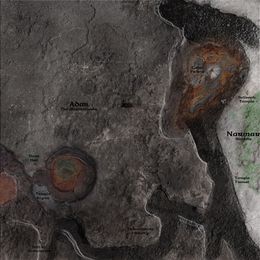 The Shadowlands of Antei
The Shadowlands of Antei
The Pau’an returned to the Dragon’s Citadel in 24 ABY, where internal and interstellar developments were causing commotion in every circle. The House—and, indeed, the whole Cocytus system—had recently been plagued by unrest and seditious activity from local populations, even to the point of attempts on the Quaestor’s life and acts of sabotage at the Silvia Industries headquarters. However, the Clan’s attention had already turned towards Antei, distracted by signs that the time to reclaim the Brotherhood’s homeworld was drawing near. Towards the end of 24 ABY, the Grand Master finally summoned the fleets of the Clans for the retaking of Antei. In a move probably calculated to reduce the possibility of inter-Clan conflict, Darth Sarin ordained that only the Dark Jedi of the Clans could set foot on the surface of Antei, supported solely by the Armed Forces of the Iron Throne, rather than the individual Clan militaries. Korroth was onboard the ISDII Warspite when the assembled fleets navigated through the Shroud and broke into the Antei system. They found only the empty husks of the alien invaders’ organic warships, and down on the planet they were not confronted by Force-devoid fiends but hostile Jedi and battle droids.
Korroth was sent as a “Foxtrot Uniform” to assist a squadron of the 13th Starborne Division in their push towards the Tomb of Okemi on the surface. Having secured the north entrance of the tomb, the Pau’an was instructed by his Clan Summit to hold his position until Palatinean reinforcements arrived, but in that interval a Journeyman from Clan Naga Sadow approached and demanded entrance. Korroth had no intention to give up his own Clan’s advantage—the opportunity to probe the secret knowledge inside the tomb was not to be missed—and a violent altercation ensued. The intervention of Iron Throne troopers put a stop to the quarrel, and Korroth retreated to a forward command post where he spent the rest of the engagement treating casualties coming in from the frontline.
The campaign on Antei ended with the death of both Darth Sarin and the Jedi leader, Omancor Crask, followed by the ascension of Muz Keibatsu Sadow, now Darth Ashen, to the Iron Throne in the restored Dark Hall. For his part, Korroth received a battlefield promotion for his efforts, but he gained much more besides that in terms of understanding the Brotherhood. The dark side of the Force gave the Clans the clout to overpower their enemies, but to him the bout with the Sadowite Journeyman was evidence that it was not a sustainable model. This first-hand experience persuaded him that the Brotherhood tended only towards division, and any semblance of unity was perhaps only an illusion.
The Cause
24 ABY - 25 ABY
After the Unification War Emperor Occasus embarked on a series of large-scale public infrastructure projects, aimed at appeasing the populace of the Cocytus system, who had been expressing unprecedented levels of public discontent. Despite the Emperor’s efforts, an insurgency called the Cause had gained ground amongst the malcontent, staging acts of sabotage, riots and bombings against the Imperial authorities on Judecca and the House planets. The rebel group had hooks in the Dragon’s Citadel itself, allegedly. A Sith Warrior’s attempt to usurp Quaestor Tra’an Reith’s position was linked to the Cause. The culprit, a supposed Sorcerer of Rhand, failed in his thrust for power, but he fled with two Journeyman followers.
At this time Korroth was in the south of Antenora helping to gather resources for the construction of a new operational base for his battleteam the Ebon Cloak. News of the attempted coup came to him over the House holofeed, but he could see with his own eyes the general state of restiveness in the Antenoran population. He travelled often between the construction site and Nas Modeh, where the battleteam sourced much of its commerce and workforce. Though it was difficult for a stranger to interact with the Soba Karemu themselves, the city was a nucleus for the trade of all the Southern Tribes. All these people had lost something in the Dragon Treaty, and the rumors of a force willing to oppose the Cocytus Empire spread like wildfire among them. Though it was doubtful that Antenora as a whole would be better off without the Empire, it was easy for market-square demagogues to hook onto the grievances of the Southern Antenorans.
These observations pushed him, in 25 ABY, to embark on a long-term study of Antenora’s main urban centers. By refining the Empire’s appreciation of Antenoran culture, religion and social issues, Korroth hoped to give Acclivis Draco the tools to bring peace and stability to the planet. He did it also to satisfy his own curiosity. He felt that exploring how the Force worked through Antenora and Scholae Palatinae to form the structure of the Empire would help him to reflect on his own connection to the Force.
Li Gandor
25 ABY
The research project began in the three cities of Li Gandor, the Northern Oasis. Suzel and Wekraneh taught Korroth how the Dragon Treaty of 13 ABY had carried the Northern Tribes to their current seats of power. These two beautiful, wealthy and opulent cities were the physical representation of the Northern Tribes’ ascendancy on Antenora. They were the apogee of what the Northern Antenorans had achieved with the backing of the Sith. However, that was the crux of the matter in the Pau’an’s eyes. Without the Empire, Hoka Dachu and Malar Denovi would be nothing. Their rulership of Antenoran lands south of Li Gandor rested entirely on the Cocytus Empire’s conquests in 13 ABY. Their control over the Southern Antenorans was merely by virtue of the blaster, supplied by Acclivis Draco for use against a largely pre-slugthrower population.
In addition to this, the Krath perceived a deep cultural, economic and spiritual divide between these tribes and the Southern Antenorans. The wealth disparity in itself was obvious, but it was also a compounding factor in the growing secularity of the Northern Tribes. Their striving for cosmopolitanism with Imperial and Galactic society drove them further away from their more conservative Antenoran cousins. This made it more difficult for them to relate to the issues and anxieties experienced by the Southern Antenorans, Korroth judged, and therefore less able to govern them successfully.
The situation was different in Patz-Ah. Korroth was well acquainted with Tribe Haka Lakuis, and he knew them to be of a very practical and efficient strain. Ever since his term as Claw of Suffering three years ago, the Pau’an had been practicing martial arts in the dojos of the city’s Academies of War. The Tribe hosted doyens from all over the galaxy. Combining their expertise with the tribe’s own traditions they developed a style resembling Shadow Step. The style was well-suited to their work in security, policing and peacekeeping, with its rapid and non-lethal techniques for subduing opponents.
Haka Lakuis had never lost its martial disposition, but it was this ability to adapt, remodel and innovate that made their rulership of eastern Antenora so effective. However, they still suffered from the same cultural estrangement of the other Northern Tribes. Over the years, this had forced them to rely increasingly on oppression and violent suppression of rebellions, methods which, in Korroth’s mind, could not be considered long-term solutions. With these disturbing observations, the Pau’an abandoned Li Gandor for the planet’s desert lands, where he hoped to plumb the depths of the gulf between the ruling and the ruled of Antenora.
Zef Demoht
25 ABY
Clambering up the slopes of the Peaks of Fire, Zef Demoht stood as proof and commentary to the wealth of Tribe Malar Denovi. The Pau’an went into the city unannounced, thus avoiding the prearranged tour of the industrial parks and the Glamiavad estates. Instead, passing off as an occupational health inspector, he snuck into the miners’ ghetto. It was while traversing its black, dust-laden alleys that he recognized the distinctive woven textiles of the Ser Gaa. He had encountered a Quod of the tribe, one of the groups that had left the desert in search of a less uncertain life in the city.
What they found was backbreaking, unending labor. Their every waking hour was spent toiling in the smelting plants and mines. Their most unbearable thought was that they saw no prospect of their situation ever changing. When Korroth chanced upon them, he found a broken people. Many times they had considered escaping the city, but their shame at having abandoned the Tribe sapped their resolve.
Korroth knew well the tendency of these people to endure hardship rather than take arms against it, but he also knew that the Ser Gaa only drew sorrow from the division of its people. The diaspora of young Antenorans had sapped the nomad tribe’s strength and ability to live in the desert. It was not easy to convince the miners in Zef Demoht of this fact, but once the Knight revealed his plan to escape the city they found their courage and accepted his help.
In his fictitious capacity as health inspector, the Pau’an went to the Glamiavad Antenorans who oversaw the miners’ ghetto and notified them of an outbreak of plyridian fever. The overseers, far from establishing a proper quarantine, fled the miners’ settlements and left the workers to their own devices. There was nobody to sound the alarm when the Ser Gaa followed Korroth out of the city during the night. They made straight for the Sea of the Rising. In the light of the dawn the Glamiavad watchposts spotted the fugitives, and a squad of company mercenaries gave chase, but the Ser Gaa shook them off in the vast Batnarean expanse.
Even as they headed towards the migratory trail of the parent tribe, the once-abject miners celebrated their new freedom. Korroth was not so exuberant. News of his seditious stunt would likely reach the Dragon’s Citadel, and there it would undoubtedly be interpreted in the light of the Cause insurrection. The Pau’an had no wish to be associated with rebels, but he felt he had embarked upon a path which brooked no deviation. The policies of the Empire’s Sith leadership had placed an untenable strain on the planet. With the balance of power so abominably skewed towards the Northern Tribes and against the Southern ones, any appearance of order could be naught but a screen, a temporary illusion sustained by violent oppression. Korroth could not do much about exalted Imperial policy, but he could put his faith in Acclivis Draco. The House had always been strong in the traditions of the Krath. The Pau’an knew that the knowledge of Antenora he was gathering would grant the Dragon’s Citadel the power to mend the planet’s societal fractures. His next destination was the shatterpoint of Antenora’s disharmony.
To Ognen
25 ABY - 26 ABY
The return of the expatriate Quod to the mother Tribe was cause for great festivities. All was forgiven and forgotten in the joy of reunion. Byeru-Tara was bedecked in banners and brilliant streamers, and the tribe danced and blared their horns around her feet. In the midst of the celebrations, the emancipated Quod gave Korroth a gift, a translucent gem which they had dug out in the deep Zef Demoht mines. In Korroth’s hand the gem radiated a violet light, revealing that it was the last lightsaber component the Krath had been looking for, a kyber crystal. The Quod had long kept it hidden in their hovels in Zef Demoht. They had never found the fortitude to use it to buy their way out of the miners’ ghetto. It was the Pau’an who had given them the courage to retake their own destiny, so the gem rightly belonged to him, they stated. Korroth took the crystal and the saber components and assembled his weapon in full sight of the Tribe. He dedicated its first ignition to them as a gesture of comradeship.
The celebrations eventually turned to a ceremony of past-recital. This was a solemn and treasured ritual, because no Tribe could be truly reunited until its members shared entirely in each others’ past history. Korroth also participated. He recounted the events of the past two years, his escapade with the Naa Ugo, the war on Antei, the construction of the Sedes Doctrinae, the rise of the Cause and his investigation of the Antenoran cities.
On this, the Ser Gaa offered their help. Several of their Drushi (family groups) still had relatives in Ognen, lost to them during the post-Dragon Treaty diaspora. If Korroth followed them to Ognen and helped them return the lost Ser Gaa into the fold of the Tribe, they would use their connections in the city to aid him in his research. This was an extraordinary opportunity for Korroth to advance his project, as Ognen was, to his knowledge, the source of the Hatwa and the center of the planet’s discontent.
Zetora
26 ABY
Six Druruni (Drush fathers) made the journey with Korroth to Ognen. The city’s white towers were prison to Tribe Pacre Datship, and the Haka Lakuis were their jailors. However, the Druruni were headed to the Zetora slums, which sprawled lawless and ungoverned at the feet of the prison towers. The group found the lost Ser Gaa beneath the tower of a lesser Quod of Pacre Datship. The twoscore-or-so Antenorans lived in woeful poverty and squalor. Their shame at being found in this state turned to anger when the Druruni explained their reason for coming to Ognen. The Zetora Ser Gaa had no intention to rejoin the Tribe. The only bond they felt was amongst themselves; when they consumed Hatwa they transcended the suffering of their separate lives and became as one greater entity. They believed they could not survive without the Hatwa.
The Druruni were shocked to learn that the drug was still in circulation. Not so Korroth, who had seen it smuggled all across southern Antenora. The words of the Zetora Ser Gaa gave a pale reflection of how the Cult of Hatza must have shaped Antenoran communities before 13 ABY, but their wretched condition now was undoubtedly an abhorrent perversion of the entheogenic origins of the drug. Nevertheless, Korroth’s and the Druruni’s exhortations to return to the Sea of the Rising did not sway them.
The Druruni headed out of the city, resigned to the failure of their mission. Korroth, however, did not give up yet. He sneaked back into the slums and observed the Zetora Ser Gaa from a distance. Eventually, the twoscore of them made their way to the foot of the prison tower, where they met an unknown Antenoran figure. Korroth, having followed them, spotted dozens of prison wardens closing in on them. He stepped in and instructed the Ser Gaa to flee and find the Druruni outside the city. The mere sight of his ignited lightsaber was sufficient to give the Ser Gaa and their unnamed acquaintance a head start. Once they were clear, the Knight allowed himself to be captured by the Haka Lakuis soldiers.
Hatwa
26 ABY
His sojourn in the Ognen prisons did not last long. In his time as Claw of the Dragon, the Krath had made connections amongst the senior officials of the military and law enforcement of Patz-Ah. All it took was a comm-call and a promise to return the favor, and he was free to go. He caught up with the Zetora Ser Gaa, who had joined the Druruni on their way to the mother Tribe. With the wardens now on the lookout for them in the city, they had no choice but to leave for the Sea of the Rising. The mysterious Antenoran now travelling with them, they revealed, was the Pacre Datship tribesman who had been supplying them with the Hatwa.
The journey was not clement on the Zetora Ser Gaa. Within a day they started to show withdrawal symptoms, which only grew more pronounced as they kept travelling. The Pacre Datship tribesman could not help them, as he had lost all his stache of Hatwa in their escape, and Korroth was struggling to keep them alive. Their long-established state of malnutrition was a severe aggravator of the dehydration caused by the drug withdrawal. The Krath estimated that more than half would not survive the trip. He needed to formulate a detox therapy to relieve their withdrawal symptoms, but for that he required Hatwa.
When the group entered the Mod valley, with Haka Lakuis patrols increasing in frequency, they suddenly turned North into the Dragon’s Teeth. The danger of recapture by Lakuan search parties had pushed the Pacre Datship tribesman to reveal the true origin of Hatwa, which, as Korroth had already begun to suspect, was not Ognen.
Aknah
26 ABY
The Pacre Datship tribesman guided the party through treacherous mountain passes, to the western valleys of the Dragon’s Teeth, and then northwards to Aknah. The ruined city was desolate, but not abandoned. The priests of the Nogarsh Hatzamin still discharged the old rites and traditions of the Ognerate, and it is with them that Korroth sought the wisdom to save his comrades. He made a deal with the distrustful priests: in exchange for what knowledge and assistance they could give, the Krath would work to keep their illegal activities hidden from the Empire. The Nogarsh Hatzamin taught Korroth the secrets of Hatwa, and Korroth used this new learning to wean the Zatori Ser Gaa off the addictive drug. The process was a long and difficult one and, despite the Pau’an’s best efforts, not all of them survived.
The Ser Gaa were Korroth’s friends, and he had seen them endure hardships that would have shattered any other people. Though he did not seek a scapegoat for their problems, he felt that his conversations with the Nogarsh Hatzamin gave him insight into the complex causes from which these hardships arose. They delivered to him many of the secrets that surrounded Hatwa, the defunct Ognerate and the foundations of Antenoran culture. Through this knowledge, it became clear to him that the Cocytus Empire professed its imposition of order and peace as its creed, but in fact it functioned by demolishing Antenoran societies and dividing tribes and peoples. Korroth observed that the tribal Antenorans, left to their own devices, found harmony with their world and with each other through their deep connection with their deities. Conversely, the interference of foreign empires (the Haka Lakuis, the Ognerate, Scholae Palatinae) worked to destabilize and weaken the tribes, targeting their spirituality and their unity.
House Scholae Palatinae
Spring Games, Antenora Cities Project, RoS:Disorder.
House Odan-Urr
Harakoans, GJWX.
Clan Odan-Urr
Between Light and Dark, Homecoming, Battle Formations
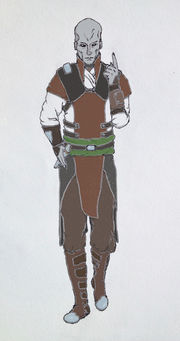 Korroth
Korroth
Profile
Physical Description
Korroth is a spindly, grey-skinned, inky-eyed, pointy-toothed Pau'an. His slender frame, straight-backed posture, long neck and tall forehead only serve to accentuate his height. No hair grows on his taupe grey skin, instead it is naturally marked by vertical pinstripe furrows. His hands have long fingers with knobbly knuckles and clawed nails.
The Pau'an's bald head is rather bony in appearance, with a prominent brow and chin, thin lips and deep orbits. The nose is the proudest feature—long, sharp and with a high bridge. The pupils of his eyes are completely black, and large enough that the white sclera is normally not visible. His ears are always covered by protective metal ear disks. He speaks with a soft gravelly voice.
Attire
Korroth's habitual attire is a white shirt, a brown tabard with a high collar, dark pants and a black split-tailed kama. A wide green sash binds his waist, and over that is a leather utility belt with a clip for his lightsaber on the right-hand side. He tucks his sleeves into leather bracers on his forearms, and the left one also incorporates his comlink. He dons durasteel-toed field boots. He may also drape a brown hooded all-temperature cloak over his shoulders. On formal occasions he will wear the more traditional earth-toned Jedi robes, but still with the green sash and black boots.
Practices and Beliefs
The Universal Conflict
As a former subject of Clan Scholae Palatinae, Korroth is fully cognizant of the power of the dark side. He has seen three Grand Masters rise to power, and he has fought several wars for and against the Dark Jedi Brotherhood. He knows that throughout history the dark side and the light side have stood as the forces of polar opposition. As long as there is a light side illuminating the Galaxy, there will be a dark side, thriving in the shadow. Korroth acknowledges this fact and sees the inevitable conflict as part of the nature of the Force.
The Pau’an believes true peace comes only at the end, when life becomes one with the Force. As long as we exist in this divided and insecure universe, we must deal with conflict. A Jedi should not turn away from this, thinking that they will find peace in this life. Instead they must face whatever conflict is put before them, strive to bring it to an end and limit its path of destruction. Even in the seeming lulls of impermanent peace, the Jedi can work to prepare themselves and the life around them for the next inevitable battle.
This is the basis of Korroth’s dedication to the Jedi Healing arts. He uses the Force to heal the wounds that this eternal war inflicts on life, and he ensures that his allies are ready for the next conflict. His practice of Vaapad can also be seen in this light, as the single purpose of this variant of Form VII is to take a fight to its most effective resolution.
The Inner Conflict
- "Ferocity in service to the Force, tranquility in all else."
- ―Korroth
Eschewing attachments is a deeply ingrained impulse in Korroth. He sees emotional bonds and desires as ultimately conducive to suffering, even if they give some small temporary pleasure. The impermanent nature of the Galaxy means that these objects of attachment will inevitably change or be destroyed, as Korroth himself has experienced several times throughout his life. The Jedi now tries to place his trust and dedication solely in the Force, the one eternal and immutable truth.
In practice however, Korroth knows that not even the wisest sage can survive without feelings, emotions and action. His bond to the Clan is too strong for him to break, even if he wanted to in the first place. Fear for the Clan’s survival is one route by which his mental composure could be broken.